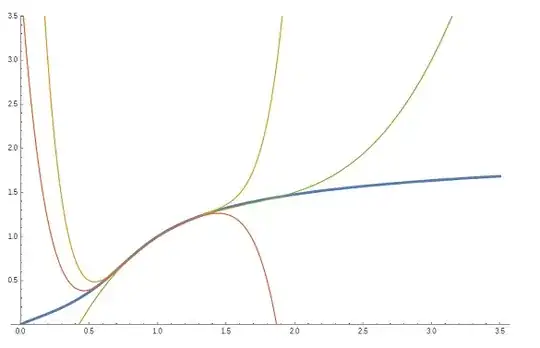How can I find the inverse function of $f(x)=x^{x^x}$? Has this inverse function ever been defined / studied? are there any asymptotic expansions?
It would be nice if the inverse of $f(x)$ could be expressed in terms of standard mathematical functions, but it would be enough for me to know even just a few properties. The inverse of $x^{x^x}$ can be linked to the inverse of $(x + a)^x$ and to the inverse of $x e^x +a x$, and many other functions, so knowing its properties can have many applications in solving a wide range of equations
Thanks
edit:
The series expansion of $x^{x^x} $ at $x=0$ can be expressed as:
$$x^{x^x}=x \sum_{j=0}^{\infty} \frac{\left( \ln(x^x)\right)^j}{j!}B_j\left( \ln(x)\right)\tag{1}$$
$B_j(x)$ is the Bell Polynomial.
By the General Leibniz rule we have that the nth derivative of $x^{x^x}$ can be shown as
$$\sum_{k=1}^n \binom{n}{k}f^{(n-k)}(x)P_j^{(k)}(\ln(x))$$
$$f(x)=x^{j+1}\Rightarrow f^{(n-k)}(x)=x^{j+1-n+k} \frac{(j+1)!}{(j+1-n+k)!}$$ $$P_j(\ln(x))=S_{j}^{(1)}\ln(x)^{j+1}+S_{j}^{(2)}\ln(x)^{j+2}+\dots+S_{j}^{(j)}\ln(x)^{j+j}$$ $S_j^{(k)}$ is the Stirling number of the second kind
$$P^{(n)}_j(\ln(x))=\sum_{k=1}^j \ \sum_{r=n-k-j}^{n-1}\frac{(j+k)!}{(j+k-n+r)!}s_{n}^{(n-r)}S_{j}^{(k)}\frac{\ln(x)^{j+k-n+r}}{x^n}$$ $s_j^{(k)}$ is the Stirling number of the first kind
$$P_j^{(n)}(\ln(1))=P_j^{(n)}(0)=\sum_{k=1}^j (j+k)!s_{n}^{(j+k)}S_{j}^{(k)}$$
Therefore the n th derivative of $x^{x^x}$ in $x = 1$ can be expressed as: $$D_n(1)=\sum_{j=1}^n\sum_{k=1}^n\sum_{h=1}^n(j+1)\frac{(h+j)!}{(j+1+k-n)!} \binom{n}{k}s_{n}^{(j+k)}S_{j}^{(k)}$$
With $n$ between $2$ and $10$ we have $D_n(1)={2,9,32,180,954,6524,45016,360144,3023640} $ A179230 obtaining an explicit form for the Taylor expansion coefficients for $x\to 1:$
$$ x^{x^x}=f(x)=x+\sum_{n=2}^{\infty}\frac{D_{n}(1)}{n!}(x-1)^n$$
Since the series has no constant terms, it is possible to express the inverse function $f^{-1} (x)$ by Series Reversion
$$f^{-1}(x)=x-(-1+x)^2+ \frac{1}{2}(-1+x)^3+\frac{7}{6}(-1+x)^4-\frac{17}{4} (-1+x)^5+O(x^6) $$
